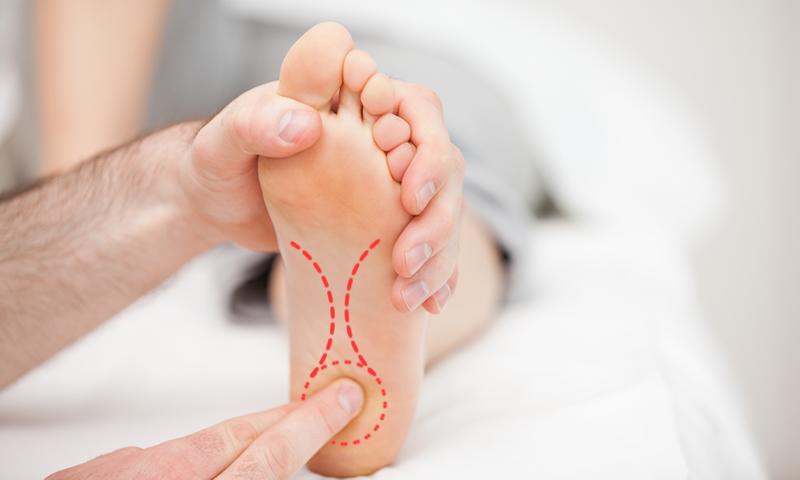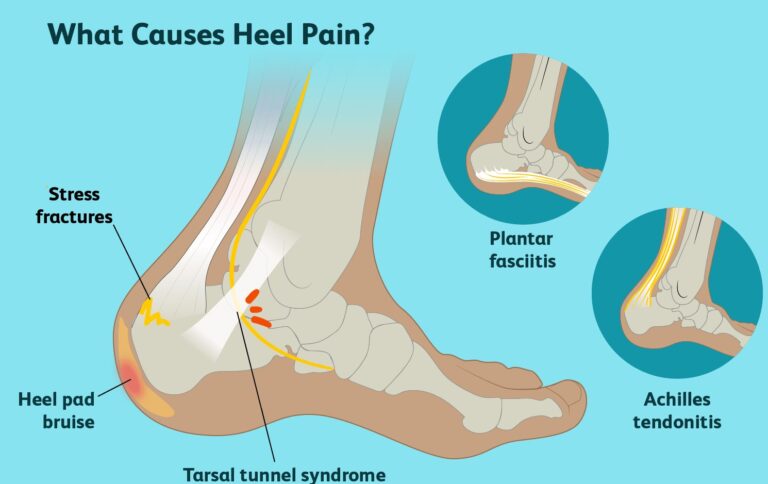HEEL PAIN
One of the most common foot problems is heel pain. Our foot and ankle consist of 26 bones, 33 joints, and more than 100 tendons. The heel is the largest bone in the foot.
Heel pain results from an overuse or injury to your heel ranging from mild to disabling pain. Heel pain could be caused from various reasons including plantar fasciitis and Achilles tendinitis. A sore heel is a common complaint about foot and ankle pain.
Pain in the heel might occur underneath the heel or behind it. Many conditions might result in heel pain including:
- Plantar fasciitis
- Achilles or flexor tendonitis/tendonosis
- Bone spurs
- Sever’s disease
- Bursitis
- Stress fractures
- Inflamed tendons
Heel pain causes difficulty in walking and participating in daily activities. Severe and painful heel conditions usually improve with nonsurgical treatments. The treatment of heel pain needs time for your body to recover.

CAUSE OF HEEL PAIN
People usually complain about pain, soreness or tenderness anywhere in the heel. Heel pain is typically felt:
- Behind the heel
- Beneath the heel
- Within the heel bone
Several problems might lead to development of pain behind the heel, such as:
Achilles tendinitis: It is also referred to as degenerative tendinopathy, tendonitis, tendinosis, and tendinopathy. This is a chronic condition related to the progressive degeneration of the Achilles tendon. It is a fibrous tissue connecting the calf muscle to the heel bone, which is the longest and strongest tendon. This is common among runners and basketball players. The overuse injury inflames the tendon causing pain, swelling and stiffness in the back of the heel. The tendon receives more tension than it can handle due to microscopic tears. Resulting in the tendon thickens, weakens, and becomes painful.
- Bursitis: This occurs as the bursae are filled with fluid causing them to swell. These sacs cushion the joints making the fluid movement easier. You might experience a tender, bruise-like feeling in the back of the heel. Bursitis normally occurs due to a lot of time being spent on your feet.
- Haglund’s deformity: Chronic inflammation and irritation leads to an enlarged bony bump in the back of the heel. Shoes with higher heels like pumps, can cause the bump and pain would worsen.
- Sever’s disease or calcaneal apophysitis: Sever’s disease is a common cause of heel pain in children between 8 and 14 active in running and jumping. The increased athletic activity irritates the growth plate in the back of the heel causing the pain in the back of the heel.
- Tarsal tunnel syndrome: The large nerve in the back of the foot becomes pinched or entrapped (compressed) causing pain in the back of heel or ankle.
Various other reasons for pain below the heel are:
- Bone bruise or contusion: The fat padding under the heel is bruised due to stepping on a hard or sharp object. Your heel will feel tender when you walk even though you might not feel discoloration. A stress fracture and Sever’s disease, might cause pain all along the back of the heel, on the bottom and side of the heel.
- Plantar fasciitis: Plantar fasciitis is the most common cause of heel pain. It is caused due to the tear or stretching of fascia, connective tissue that runs along the bottom or plantar surface of the foot. People who run and jump are prone to develop this painful condition. Treadmills and hard surfaces for exercise or work are common irritants.
- Heel spurs: Chronic plantar fasciitis can cause a bony growth or heel spur to develop on the heel bone resulting in painful condition.
- Chronic Inflammation of heel pad: it is usually caused when the heel pad becomes thin or due to heavy footsteps.
Stress fractures are linked to repetitive stress, strenuous exercise, sports, or heavy manual work and they might affect any part of the heel. Runners are commonly prone to stress fracture in the metatarsal bones of the foot and usually caused by osteoporosis.
Various other reasons that might lead to heel pain are:
- Baxter’s nerve entrapment
- Calcaneal cysts
- Soft tissue mass
- Short flexor tendon tear
- Systemic arthritis such as lupus, rheumatoid arthritis, psoriatic arthritis
- Bone bruise
- Poor posture while walking or running
- Bone cyst leading to fluid-filled cyst in a bone
- Gout
- Morton’s neuroma
- Osteomyelitis, an infection of the bone or bone marrow

SYMPTOMS OF HEEL PAIN
- Heel pain symptoms usually vary depending on the cause.
- Bony growth on the heel
- Discoloration (bruising or redness)
- Stiffness
- Swelling
- Tenderness
- Pain after standing from a resting or sitting position
- Pain on the bottom of the heel or arch of the foot
- Pain worsen upon arising
- Pain that increases over a period of months
- Swelling on the bottom of the heel
DIAGNOSIS OF HEEL PAIN
To arrive at a diagnosis, a podiatrist will obtain your medical history and examine your foot.
Diagnostic imaging studies, such as x-rays or other imaging modalities, are used to distinguish the different types of heel pain. Sometimes heel spurs are found in patients with heel problems. Heel spurs are usually found if you are suffering from plantar fasciitis.
Rarely, the podiatrist would recommend MRI or ultrasound to diagnose defect in soft tissue problems which X-rays don’t reveal.

TREATMENT OF HEEL PAIN
The treatment regime depends on the cause of the heel pain. For mild to moderate pain podiatrist would recommend non-surgical treatment methods such as:
- Stretching exercises: Exercises that stretch the calf muscles help ease pain as well as assist with speedy recovery.
- Avoid going barefoot: Walking without shoes puts undue strain and stress on your heel causing pain and inflammation.
- Ice: Putting an ice pack on your heel several times a day helps reduce inflammation.
- Limit activities: Extended hours of physical activities puts a lot of pressure on your heel. This might damage the nerve and the bone leading to pain ranging from mild to severe.
- Shoe modifications: Wearing supportive shoes provide good arch support and a slightly raised heel reduces stress.
- Medications: Oral non-steroidal anti-inflammatory drugs (NSAIDs like ibuprofen, might be recommended to reduce pain and inflammation.
If you still feel pain even after several weeks, you should visit a podiatrist. They would change the treatment regime to provide relief:
- Padding, taping and strapping: Pads, strapping and taping in the shoe softens the impact of walking. They also help support the foot and reduce strain on the fascia.
- Orthotic devices: Custom orthotic devices fit into the shoe. These help correct the underlying structural abnormalities causing heel pain.
- Injection: Corticosteroid injections are used to reduce the inflammation and relieve pain.
- Walking cast: A removable walking cast is helpful to keep your foot immobile for a few weeks to allow it to rest and heal.
- Night splint: Wearing a night splint helps you to maintain an extended stretch while sleeping. This may also help reduce the morning pain.
- Physical therapy: Exercises and other physical therapy measures are also used to provide relief from various causes of heel pain.
OUTLOOK
Heel pain usually resolves with nonsurgical treatments, but the recovery might take time. If you quickly return to your usual activities it can set back your recovery. In rare situations, the podiatrist might suggest surgery. Heel pain sometimes can be disabling and affect your daily movements along with change in the way you walk.
If you or anyone you know is suffering from foot problems, our expert providers at Specialty Care Clinics will take care of your health and help you recover.
Call us on (469) 545-9983 to book an appointment with our specialists.
